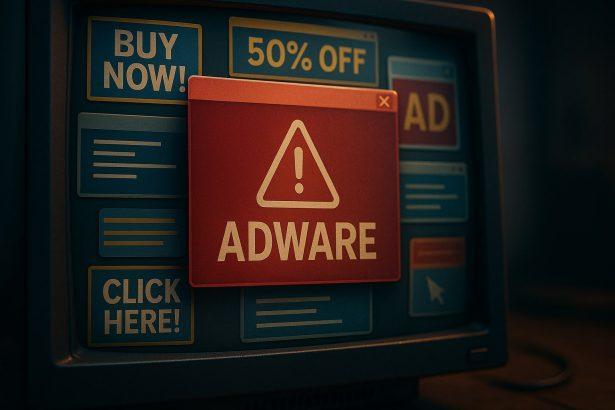If you’re seeing intrusive pop‑ups or notifications from meethuhesurvey.top, you’re dealing with deceptive tactics aimed at tricking you into clicking or sharing personal info. Let’s break it down and help you fix it.
Threat Overview: Ads by Meethuhesurvey.top
- What it is: A deceptive website offering “surveys” claiming you can win money or prizes. It tricks you into allowing push notifications that deliver misleading messages or ads.
- How it works: Presents prompts like “You’ve been selected” or “Become a millionaire” along with deceptive “Allow Notifications” requests. Once allowed, these notifications can redirect you to scam or malware-laden sites.
- Risks & Signs:
- Unexpected ads not tied to your current browsing
- Performance slowdowns or browser lag
- Potential spyware or additional malware installations
Quick Threat Summary
| Category | Details |
|---|---|
| Threat Name | Ads by meethuhesurvey.top |
| Threat Type | Push notifications ads, unwanted pop‑ups |
| Typical Triggers | Misleading website content prompting permission for notifications |
| Symptoms | Random pop‑up ads, system slowdowns, browser tracking |
| Damage | Privacy intrusion, performance issues, potential malware infection |
| Distribution Methods | Deceptive ads, bundled software, rogue sites or torrents |
How Did You Get Infected?
You likely visited a low-reputation site (e.g., torrent, streaming, or cracked software platforms) that prompted you to “prove you’re human” by clicking “Allow.” That action automatically granted the site permission to push notifications to your desktop.
Once allowed, even if you close the tab, those notifications can continue appearing until the permission is revoked.
Immediate Actions to Take
- Revoke Notification Access
- Chrome: Menu → Settings → Privacy & Security → Site Settings → Notifications → Remove meethuhesurvey.top
- Firefox: Menu → Settings → Privacy & Security → Permissions (Notifications) → Remove site
- Edge: Menu → Settings → Cookies & site permissions → Notifications → Remove site
- Scan Your System
Use trusted anti-malware tools (e.g., Malwarebytes, HitmanPro, AdwCleaner, or Combo Cleaner) to detect and eliminate any bundled adware or malicious software files. - Reset Your Browser (If Ads Persist)
Restore your browser to its default settings to remove hidden extensions or configurations. - Use an Ad Blocker
Installing an ad-blocker like AdGuard can help prevent malicious redirects from shady sites in the future.
How to Stay Safe Going Forward
- Always block notification requests from sites you don’t completely trust.
- Take the “Custom/Advanced” option when installing free software to uncheck additional bundled offers.
- Avoid sketchy sites that rely on heavy advertising or questionable redirect tactics.
- Keep browser and antivirus software updated to stay protected from emerging scam tactics.
Manual Adware Removal Process (Windows & Mac)
Step 1: Identify and Uninstall Suspicious Applications
For Windows Users
- Open Task Manager by pressing
Ctrl + Shift + Esc. - Navigate to the “Processes” tab and search for unknown or high-resource-consuming processes.
- If you detect anything suspicious, right-click and select “End Task.”
- Go to
Control Panel>Programs>Programs and Features. - Locate and uninstall any unfamiliar programs.
For Mac Users
- Open
Finderand click onApplications. - Identify and move any suspicious applications to the
Trash. - Empty the
Trash. - Check
System Preferences>Users & Groups>Login Itemsfor unknown startup programs and remove them.
Step 2: Remove Malicious Browser Extensions
Google Chrome
- Open Chrome, click
Menu(three dots) >Extensions. - Locate and remove unknown extensions.
- Reset Chrome:
Settings>Reset settings> “Restore settings to their original defaults.”
Mozilla Firefox
- Click
Menu>Add-ons and themes. - Remove suspicious extensions.
- Reset Firefox:
Help>More troubleshooting information> “Refresh Firefox.”
Safari (Mac)
- Open Safari, go to
Preferences>Extensions. - Delete unknown extensions.
- Reset Safari:
History> “Clear History.”
Microsoft Edge
- Click
Menu>Extensions. - Remove any unfamiliar extensions.
- Reset Edge:
Settings>Reset settings> “Restore settings to their default values.”
Step 3: Delete Adware-Associated Files and Folders
For Windows Users
- Press
Win + R, type%AppData%, and press Enter. - Locate and delete suspicious folders.
- Repeat for
%LocalAppData%,%ProgramData%, and%Temp%.
For Mac Users
- Open Finder and press
Shift + Command + G, then enter~/Library/Application Support/. - Remove any suspicious folders.
- Repeat for
~/Library/LaunchAgents/,~/Library/LaunchDaemons/, and~/Library/Preferences/.
Step 4: Flush DNS Cache to Remove Adware Traces
For Windows Users
- Open
Command Promptas Administrator. - Type
ipconfig /flushdnsand press Enter.
For Mac Users
- Open
Terminal. - Enter
sudo killall -HUP mDNSResponderand press Enter.
Step 5: Restart Your System
Perform a reboot to apply the changes and ensure the removal process is complete.
Automatic Adware Removal Using SpyHunter (Windows & Mac)
For an effortless and effective solution, use SpyHunter, a powerful anti-malware tool designed to detect and remove adware completely.
Step 1: Download SpyHunter
Click the link to download SpyHunter: Download SpyHunter Here.
Step 2: Install SpyHunter
Follow the installation guide based on your operating system:
For Windows Users
- Run the downloaded
.exefile. - Follow the installation instructions.
- Launch SpyHunter and allow it to update its malware database.
For Mac Users
- Open the downloaded
.dmgfile. - Drag and drop SpyHunter into
Applications. - Open SpyHunter and let it update its database.
Step 3: Scan and Remove Adware
- Open SpyHunter.
- Click
Start Scan. - Wait for the scan to complete.
- Click
Fix Threatsto remove detected malware.
Step 4: Restart Your Computer
After SpyHunter removes all threats, restart your system to ensure all adware components are fully removed.
Final Thoughts
You’re not dealing with a traditional virus—but a sophisticated form of adware focused on tricking you via push notifications. The good news? You can stop it:
- Revoke notification permissions
- Run a full malware scan
- Tighten up your browsing habits
Need help resetting your settings or picking a trusted anti-malware tool? I’ve got your back—just say the word!




